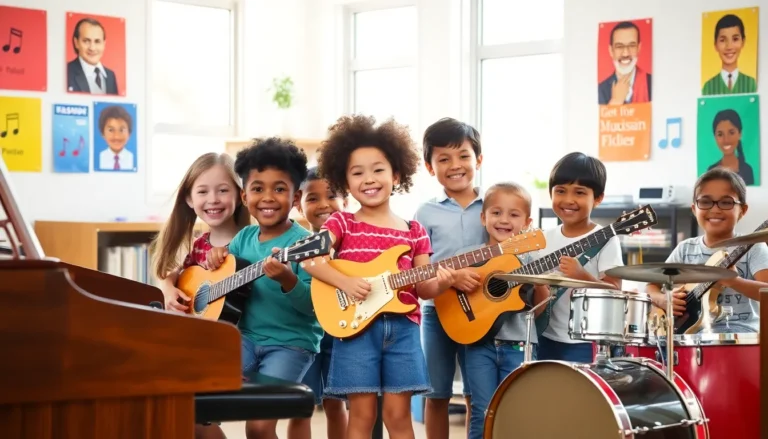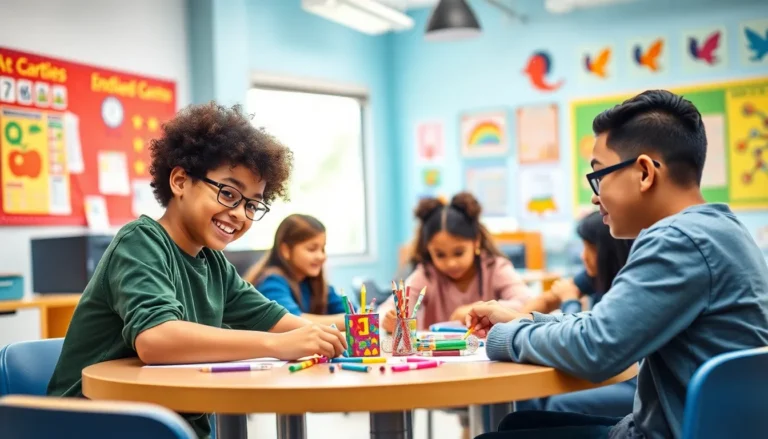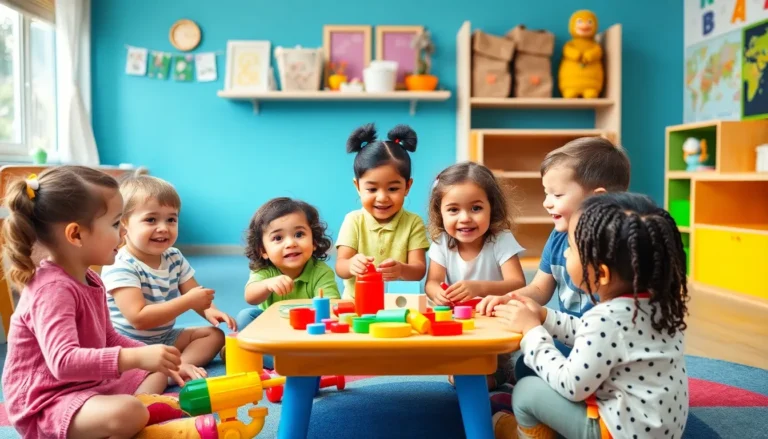In a world where knowledge is power, higher learning stands as the ultimate key to unlocking doors of opportunity. Picture this: a place where caffeine flows like water, late-night study sessions turn into bonding experiences, and the only thing more diverse than the student body is the array of pizza toppings available at 2 a.m. It’s not just about textbooks and lectures; it’s where minds expand and futures are forged.
Table of Contents
ToggleOverview Of Higher Learning
Higher learning refers to education beyond high school, encompassing universities, colleges, and vocational institutions. Students pursue diverse fields of study, gaining knowledge and skills that align with their career aspirations.
Graduation rates reflect the commitment students show towards their future. According to the National Center for Education Statistics (NCES), approximately 62% of students who begin a bachelor’s degree complete it within six years. This completion rate underscores the challenges many face during their educational journey.
Academic programs vary widely. Students can choose from liberal arts, sciences, engineering, business, and many more. Each discipline equips individuals with specific expertise applicable in their chosen careers.
Beyond academics, higher education fosters personal development. Engaging in extracurricular activities enhances leadership and teamwork skills. Networking opportunities abound, as students build relationships with peers and professors that may last a lifetime.
Cultural exposure in higher education offers students unique perspectives. They interact with diverse individuals, enriching their understanding of global issues. Study abroad programs and international exchanges provide experiences that broaden horizons beyond classroom walls.
Investing in higher education pays off. The Bureau of Labor Statistics indicates that individuals with a bachelor’s degree earn approximately $1,200 weekly, compared to $748 for those with only a high school diploma. This wage difference highlights the financial benefits associated with higher learning.
Overall, higher education serves as a powerful tool for personal and professional growth. It shapes careers and lives through knowledge acquisition and social interaction.
Themes Explored In Higher Learning

Higher learning delves into various themes that impact students’ lives profoundly. This section examines key aspects such as social issues and personal growth.
Social Issues
Social issues present significant challenges within higher education. Inequality surfaces as a primary concern, affecting access to resources and opportunities. Many students confront systemic barriers based on socioeconomic status, race, or gender. Inclusivity plays a crucial role in fostering a supportive environment for individuals from different backgrounds. Campus dialogues often focus on current events, shaping students’ awareness and engagement. Meanwhile, mental health awareness has gained traction, with universities implementing programs to address these crucial needs. Promoting activism within the student body encourages social responsibility, giving students a platform to voice their concerns.
Personal Growth
Personal growth becomes evident through the higher learning experience. Academic challenges instill resilience, equipping students with problem-solving skills for future endeavors. Developing critical thinking is vital as students encounter diverse perspectives. Extracurricular activities offer excellent opportunities for leadership and teamwork, bridging gaps between theory and practice. Networking with peers and faculty cultivates meaningful relationships that extend beyond college. Cultural exposure through various programs enriches students’ worldviews and fosters adaptability. Ultimately, personal growth shapes well-rounded individuals prepared for the complexities of professional life.
Character Development
Character development plays a crucial role in higher learning, with individuals revealing their unique traits and growth throughout their educational journey.
Protagonist Analysis
Every student embodies the protagonist, navigating through challenges and opportunities. Each individual’s experiences shape their identity, emphasizing resilience and adaptability. Some face academic pressures, while others build leadership skills in extracurricular settings. Growth manifests as students confront obstacles, hone critical thinking, and engage in diverse perspectives. Factors such as cultural exposure and social interactions support this development. As they connect with peers from varied backgrounds, they contribute to their personal narratives. Each story illustrates the transformative power of education, fostering individuals ready for professional and personal challenges.
Supporting Characters
Supporting characters enhance the college experience, enriching personal growth and fostering a sense of community. Peers provide encouragement during late-night study sessions, helping each other through academic stress. Mentors, such as professors and advisors, guide students toward achieving their goals. Relationships formed in extracurricular activities offer opportunities for teamwork and collaboration. Family support remains vital, reinforcing the importance of educational pursuits and the hard work involved. Each interaction shapes character, contributing to a well-rounded individual prepared for future endeavors. Diversity within this network promotes inclusivity and understanding, cultivating a rich learning environment.
Cinematic Techniques
Cinematic techniques play a crucial role in depicting the theme of higher education. These artistic choices enhance storytelling, creating a deeper emotional connection with the audience.
Direction and Cinematography
Direction shapes the overall vision of a film, while cinematography amplifies that vision through visual storytelling. Directors use camera angles, movements, and framing to align with the narrative’s emotional tone. For instance, close-ups can illustrate characters’ introspective moments, inviting viewers to connect intimately with their struggles. Wide shots might contrast individual journeys against sprawling campuses, depicting the broader context of higher education. Additionally, lighting sets the mood, often reflecting the contrasting experiences of hope and challenge inherent in college life.
Soundtrack and Score
Soundtrack and score significantly influence how viewers perceive and engage with a film. A well-crafted score evokes emotions, perfectly complementing key moments in a character’s journey. For example, uplifting melodies can underscore triumphant achievements, while somber notes might accompany struggles faced by students. Soundtracks often feature contemporary music, resonating with the youth culture found on campuses. Carefully selected songs can foster nostalgia and nostalgia, connecting audiences to their own educational experiences. Ultimately, these auditory elements enhance storytelling, adding layers to the cinematic portrayal of higher learning.
Critical Reception
Critical reception of higher education has showcased varied opinions across different platforms. Reviews often highlight the transformative power of higher learning, emphasizing its role in shaping not just careers but also identities. Many experts assert that students enjoy unique life experiences, fostering significant personal growth alongside academic achievements.
Critics point to challenges such as access inequality and mental health issues on campuses. Students from marginalized backgrounds frequently encounter obstacles impacting their educational journeys. Various studies reveal that almost 62% of individuals pursuing bachelor’s degrees graduate within six years. This statistic underscores the commitment and resilience students demonstrate in their pursuits.
Cinematic portrayals of college life contribute to public perceptions of higher education. Films often depict vibrant campus cultures and the diversity of student experiences, captivating audiences. Direction and cinematography enhance these narratives, using visual techniques to evoke emotional connections. Music in these films resonates with youth culture, reinforcing messages about the challenges and triumphs students face.
Scholarships and financial aid opportunities highlight the economic dimensions of higher education, making it accessible to broader demographics. Graduates with bachelor’s degrees reported earning significantly more than those without, emphasizing the long-term benefits of higher learning. Lastly, advocacy for inclusivity and social responsibility garners attention, as student activism plays a critical role in promoting change on campuses.
Data and commentary suggest that while higher education offers immense benefits, ongoing dialogue about accessibility and mental health remains crucial for holistic development.
Higher education serves as a cornerstone for personal and professional development. It not only opens doors to career opportunities but also fosters essential life skills and resilience. The diverse experiences within academic settings shape individuals into well-rounded members of society.
As students navigate their educational journeys they build relationships and engage with diverse perspectives that enrich their lives. The challenges they face cultivate critical thinking and adaptability essential for future success.
While the benefits of higher education are clear the conversation around accessibility and mental health remains vital. Ensuring that all students have the support they need will enhance the transformative power of education. Ultimately higher learning is about more than just degrees; it’s about growth and the pursuit of a meaningful life.





